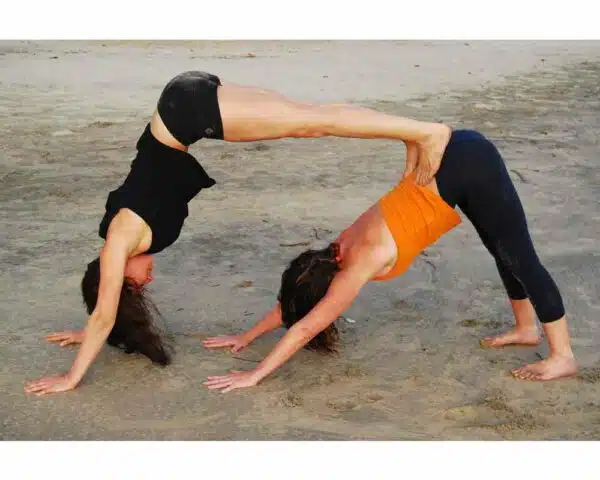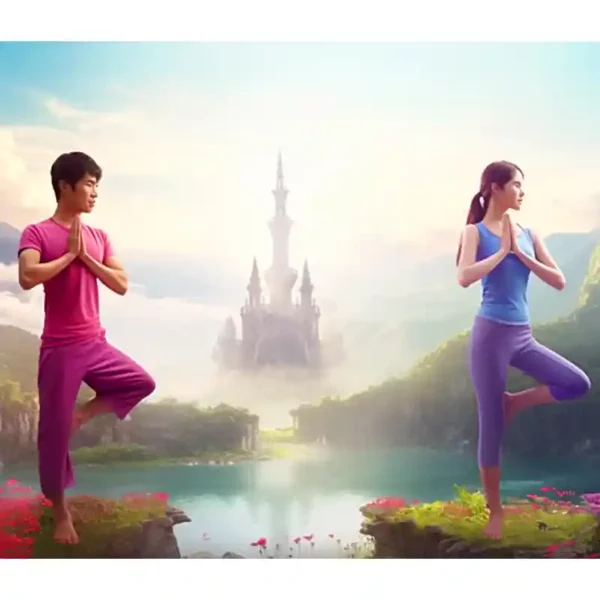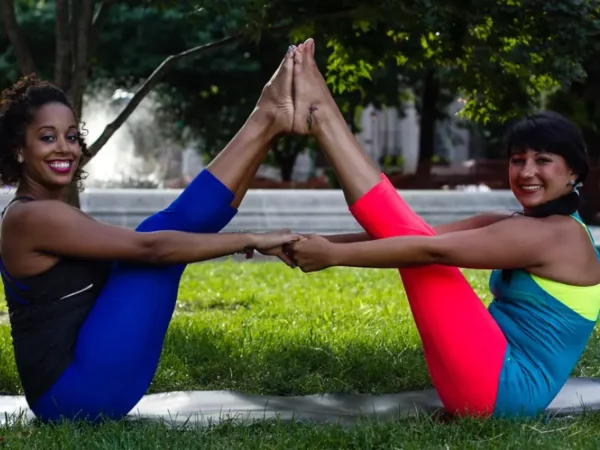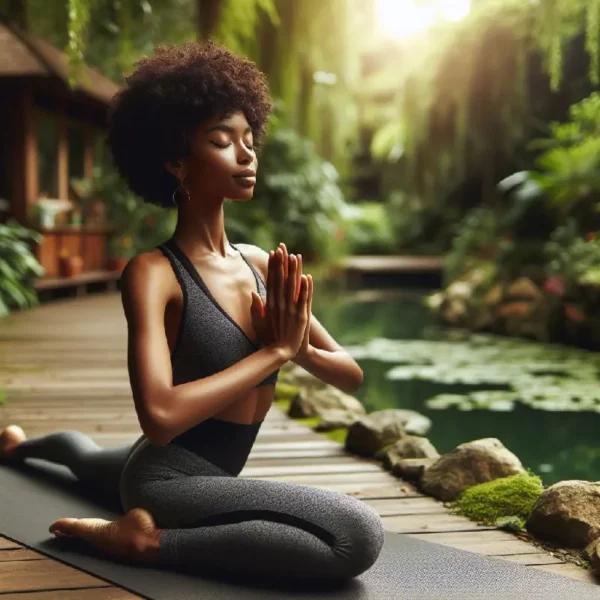In a world that races ahead, cherishing moments of bonding and serenity will become valuable. What’s more worthwhile than embarking on a well-being and camaraderie adventure together with your excellent pal? Enter BFF 2-individual yoga poses—a delightful fusion of bodily exercise and friendship. A daily diet chart for weight loss lets you plan your meals and snacks according to your calorie and vitamin needs, while yoga can help you burn energy, reduce pressure, and improve your mindfulness of consuming. From deepening stretches to fostering belief and laughter, these companion yoga poses offer a remarkable experience. In this blog, we’ll delve into BFF 2-man or woman yoga poses, uncovering their blessings, guiding your strategies, and revealing how they rework well-being and friendship.
20 BFF 2-Person Yoga Poses
Double downward-going through canine (Adho mukha savasana): Both partners start in a downward-facing dog pose, with their arms and toes on the ground and their hips lifted up. The companion who’s on the pinnacle places their hands at the lower back of the partner who is on the bottom and lightly walks their feet up their legs until they attain a cushy position. Both partners hold their arms and legs straight and press their heels down. They breathe deeply and preserve the pose for a few breaths.
- Doubletree poses (Vrksasana):

Both companions stand next to each other, dealing with the same path. They convey their right feet up and place them on the inside of their left thighs, forming a tree pose. They press their proper knees again and balance on their left legs. They convey their hands collectively in front of their chests and then amplify their fingers overhead. They appeared straight beforehand or slightly up. They repeat the pose on the alternative facet. A couple doing a double tree yoga pose.
- Double plank pose (Phalak asana):

Both partners face each other and get right into a plank pose, with their fingers below their shoulders and their bodies in a straight line. They lift their right legs and region them on the pinnacle of every other’s left leg, forming a move. They squeeze their inner thighs collectively and interact with their middle muscle groups. They hold the pose for a few breaths, after which they switch legs.
- Double boat pose (Navasana):

Both partners sit, going through each other with their knees bent and their feet on the ground. They hold each other’s hands and lean again slightly, lifting their feet off the ground. They straighten their legs and bring them parallel to the floor, forming a boat pose. They hold their backs straight and their chests open. They hold the pose for a few breaths.
- Double chair pose (Utkatasana):
Both companions stand again to return with their toes hip-width apart. They bend their knees and lower their hips as though sitting on a chair. They amplify their fingers ahead and parallel to the ground, with their fingers facing down. They press their backs against each other and maintain their weight on their heels. They maintain the pose for a few breaths.
- Double warrior I pose (Virabhadrasana I):
Both partners stand, dealing with opposite instructions, with one accomplice in front of the other. The accomplice who’s in front steps their right foot forward and bends their right knee, forming a lunge. The accomplice, who’s at the back, steps their left foot lower back and straightens their left leg, aligning it with the front partner’s right leg. Both partners elevate their palms up and overhead, with their arms going through each other or touching. They look up at their hands or directly in advance. They repeat the pose on the other side.
- Double Warrior II pose (Virabhadrasana II):
Both partners stand, dealing with contrary guidelines, with one partner in front of the other. The accomplice, who is in front, steps their proper foot out to the right and bends their proper knee, forming a lunge. The companion who is behind steps their left foot out to the left and straightens their left leg, aligning it with the front companion’s proper leg. Both partners make their palms out to the sides, with their arms facing down. They look over their front palms or at each other’s eyes. They repeat the pose on the alternative aspect.
- Double triangles pose (Trikonasana):
Both partners stand facing contrary instructions, with one partner in front of the other. The associate who’s in front steps their proper foot out to the right and straightens both legs, forming a wide stance. The accomplice, who is in the back, steps their left foot out to the left and straightens both legs, aligning them with the front associate’s proper leg. Both companions reach their right arms down and touch their right ankles or shins at the same time, lifting their left palms as much as the sky, forming a triangle. They twist their torsos barely enough to face each other or look up at their top fingers. They repeat the pose on the opposite side.
- Double half-moon pose (Ardha Chandrasana):
Both partners stand going through the identical route, with one partner in front of the other. The companion who’s in the front steps their proper foot ahead and lifts their left leg up, forming a half-moon pose. The partner who’s in the back places their right hand on the front companion’s proper hip and lifts their left leg up, aligning it with the front companion’s left leg. Both companions attain their left fingers up and overhead, forming an instant line from their fingers to their toes. They appear up at their pinnacle arms or each other. They repeat the pose on the opposite side.
- Double camel pose (Ustrasana):
Both partners kneel on the ground, going through each other. They place their fingers on each other’s shoulders and lean back, arching their backs and lifting their chests. They press their hips ahead and maintain their thighs perpendicular to the floor. They tilt their heads again and look up or gaze into everyone’s eyes. They preserve the pose for a few breaths.
- Double cobra pose (Bhujangasana):
Both partners lie on their stomachs, going through each other. They place their fingers beneath their shoulders and raise their heads and chests off the floor, forming a cobra pose. They bring their feet together and press them towards each other’s toes. They smile at each other and preserve the pose for a few breaths.
- Double bow pose (Dhanurasana):
Both companions lie on their stomachs, dealing with opposite guidelines, with one companion in front of the other. The accomplice who’s in front bends their knees and reaches their lower back to grab their ankles, forming a bow pose. The partner who’s behind bends their knees and reaches forward to grab the front partner’s ankles, forming an opposite bow pose. Both companions raise their chests and thighs off the floor and rock lightly backwards and forward. They breathe deeply and hold the pose for a few breaths.
- Double bridge pose (Setu bandha sarvangasana):
Both partners lie on their backs, going through opposite guidelines, with one accomplice in front of the other. The partner who’s in front bends their knees and places their feet flat on the ground, near their hips. The companion who is behind places their feet on top of the front associate’s knees and straightens their legs, forming a bridge pose. Both partners place their hands on the ground beside their ears and raise their hips and chests off the floor, forming a wheel pose. They press their toes and hands firmly onto the floor and preserve the pose for a few breaths.
- Double wheel pose (Urdhva dhanurasana):
Both partners lie on their backs, facing opposite guidelines, with one partner in front of the other. The companion who’s in front bends their knees and places their toes flat on the ground, close to their hips. The accomplice, who is in the back, places their foot on the pinnacle of the front partner’s foot and bends their knees, forming a bridge pose. Both companions place their fingers on the ground beside their ears and raise their hips and chests off the ground, forming a wheel pose. They press their toes and arms firmly onto the ground and preserve the pose for a few breaths.
- Double pigeon poses (Eka pada rajakapotasana):

Both partners sit down, going through each other with their legs crossed. They place their proper shins on the pinnacle of each other’s left shins, forming a double pigeon pose. They flex their toes and press them in opposition to everyone’s legs. They maintain each other’s fingers and lean ahead slightly, feeling a stretch of their hips and lower back. They breathe deeply and preserve the pose for a few breaths. They repeat the pose on the other aspect.
- Double cow face pose (Gomukhasana):
Both companions take a seat, going through every step with their legs crossed. They place their proper knees on the pinnacle of each other’s left knees, forming a cow-face pose. They bring their proper fingers behind their backs and reach for each other’s right wrists or arms. They carry their left fingers over their heads and reach for each other’s left wrists or palms. They lift their chests and decrease their shoulders, feeling a stretch of their hands and chest. They examine each other or those near their eyes. They repeat the pose on the other side.
- Double-seated forward fold pose (Paschimottanasana):
Both companions sit down, going through each other with their legs extended ahead. They carry the soles of their feet together and preserve them with their fingers. They inhale and lengthen their spines, then exhale and fold forward from their hips, bringing their foreheads in the direction of every person’s foot. They loosen up their necks and shoulders and breathe deeply. They maintain the pose for a few breaths.
- Double fish pose (Matsyasana):
Both partners lie on their backs, going through contrary guidelines, with one accomplice in front of the other. The partner who’s in the front bends their elbows and locations them under their shoulders, then lifts their head and chest off the floor, forming a fish pose. The accomplice, who’s in the back, places their head on the front companion’s chest and lifts their legs over their head, forming a plough pose. Both partners press their elbows and feet onto the floor and hold the pose for a few breaths.
- Double corpses pose (Savasana):
Both partners lie on their backs, dealing with contrary guidelines, with one associate in front of the other. They bring their feet together and let them fall to the edges, forming a butterfly pose. They bring their hands to the perimeters and allow them to relax on the floor, arms going up. They close their eyes and loosen up their entire body, feeling a sense of calm and peace. They breathe deeply and hold the pose for as long as they like.
- Double lotuses pose (Padmasana):
Both companions take a seat, going through each other with their legs crossed. They deliver their right toes up and place them on the inside of their left thighs, forming a 1/2-lotus pose. They deliver their left toes up and place them on the inside of their proper thighs, forming a complete lotus pose. They bring their palms together in front of their chests and bow to each other, acknowledging their connection. They preserve the pose for a few breaths.
Benefits of BFF 2-Person Yoga Poses:
Exploring yoga with your excellent pal isn’t just about placing brilliant poses; it’s a unique journey that gives a multitude of physical, mental, and emotional blessings. Partner yoga, or BFF yoga, not only deepens your bond but also enhances your typical well-being in great ways.
- Strengthening Communication and Trust
Partner yoga calls for clear conversation and mutual agreement. As you work collectively to reap poses, you learn how to speak efficiently, verbalising your needs and presenting help. This shared revelry builds a more potent basis for your friendship, fostering openness and honesty.
- Enhancing Flexibility and Balance
Many BFF yoga poses involve helping each other stretch further or maintain stability. This dynamic collaboration allows you to get admission to deeper stretches and demanding situations, enhancing your stability in ways that individual exercise might not. Over time, you’ll see improved flexibility and higher equilibrium.
- Deepening the Stretch
Partner yoga regularly enables deeper stretches, mainly in poses that involve assisting each other in gentle but powerful stretches. This can lead to expanded muscle flexibility and joint mobility, improving normal physical fitness.
- Encouraging mindfulness
Practising associate yoga demands a centred interest in your body and your friend’s actions. This heightened recognition fosters mindfulness, helping you stay present in the intervening time and cultivate a sense of tranquillity.
- Providing emotional support
Through accomplice yoga, you and your excellent pal percentage embark on a unique journey that goes beyond the body. The act of supporting each other through poses fosters an experience of emotional guidance, creating a safe space for explicit emotions and concerns.
- Boosting confidence
Successfully reaching accomplice poses can enhance your confidence stages. The shared accomplishment reinforces the concept that together, you can conquer demanding situations and obtain your dreams.
- Building a Sense of Playfulness
BFF yoga injects a sense of playfulness into your exercise. As you navigate poses collectively, you’re in all likelihood to share laughter and joy, reminding you that yoga isn’t simply extreme; it’s additionally about having amusement.
- Creating Lasting Memories
Partner yoga creates memorable studies that you and your buddy will cherish. These shared moments of laughter, challenge, and accomplishment contribute to the specific tapestry of your friendship.
- Strengthening Core Muscles
Many companion poses require centre engagement for balance. As you assist and aid each other, your centre muscle groups are constantly at work, leading to improved middle energy over time.
- Promoting relaxation
Partner poses frequently involve mild pressure and support, encouraging rest and the release of tension. This can cause reduced stress levels and an overall sense of well-being.
Conclusion:
As we conclude our exploration of BFF 2-individual yoga poses, we are hoping you’re inspired to embark on this precise adventure along with your closest accomplice. These poses go beyond bodily motion; they beef up bonds, inspire mindfulness, and create lasting memories. The splendour of practicing yoga together lies not only in the postures but also in the shared laughter, trust, and growth that they foster. So, whether you’re giggling your manner through a balancing act or finding serenity in a mild stretch, recollect that each pose is a step towards deeper connection and greater well-being. So, clutch your friend’s hand, unroll your mats, and let the journey of BFF 2-man or woman yoga poses raise your friendship and improve your lives in ways you never thought possible.
